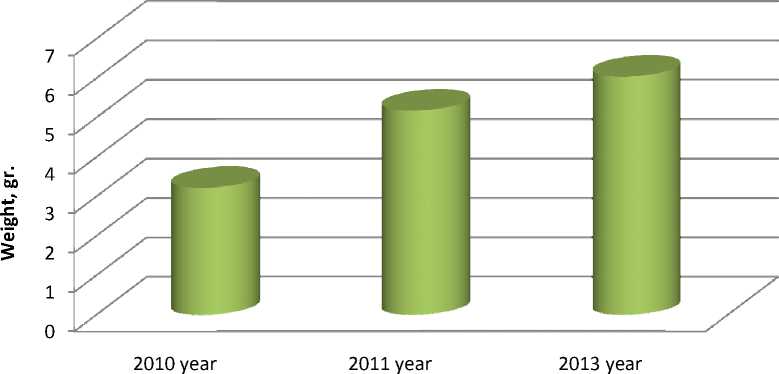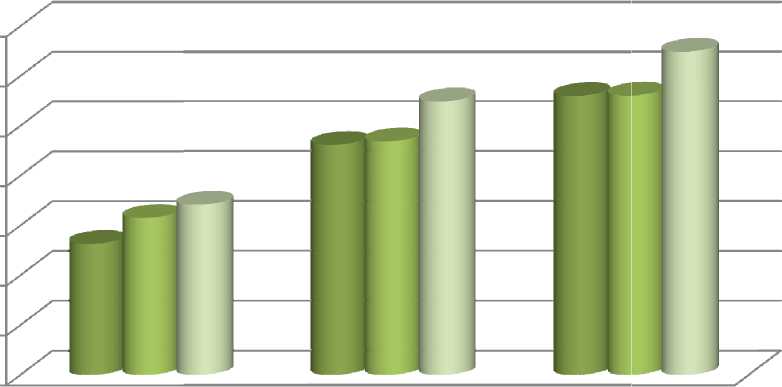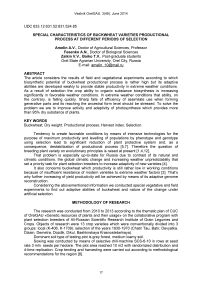Special characteristics of buckwheat varieties productional process at different periods of selection
Автор: Amelin A.V., Fesenko A.N., Zaikin V.V., Boiko T.V.
Журнал: Вестник аграрной науки @vestnikogau
Статья в выпуске: 3 (48), 2014 года.
Бесплатный доступ
The article considers the results of field and vegetational experiments according to which biosynthetic potential of buckwheat productional process is rather high but its adaptive abilities are developed weakly to provide stable productivity in extreme weather conditions. As a result of selection the crop ability to organic substance biosynthesis is increasing significantly in favorable weather conditions. In extreme weather conditions that ability, on the contrary, is falling quickly. Sharp falls of efficiency of assimilate use when forming generative parts and its reaching the ancestral form level should be stressed. To solve the problem we are to improve activity and adaptivity of photosynthesis which provides more than 95% dry substance of plants.
Buckwheat, dry weight, productional process, harvest index, selection
Короткий адрес: https://sciup.org/147124546
IDR: 147124546 | УДК: 633.12:631.52:631.524.85
Текст научной статьи Special characteristics of buckwheat varieties productional process at different periods of selection
Tendency to create favorable conditions by means of intensive technologies for the purpose of maximum productivity and levelling of populations by phenotype and genotype using selection lead to significant reduction of plant protective system and, as a consequence, destabilization of productional process [5,7]. Therefore the question of breeding plant variety on evolutionary principles is raised at present [1,4,12].
That problem is especially up-to-date for Russia due to contrast of its natural and climatic conditions, the global climatic change and increasing weather unpredictability that set a priority task for plant selection breeders to increase adaptivity of new varieties [4].
It also concerns buckwheat which productivity is still rather low in working conditions because of insufficient resistance of modern varieties to extreme weather factors [2]. That’s why further increasing of yield productivity will be achieved by means of its adaptive genome reconstruction.
Considering the abovementioned information we conducted special vegetative and field experiments to find out adaptive abilities of buckwheat and nature of the change under artificial selection.
METHODOLOGY OF RESEARCH
The research was conducted from 2010 to 2013 according to the thematic plan of CUC of OrelGAU «Genetic resources of plants and their usage» on the collaborative program with plant selection breeders of All-Russian Scientific Research Institute of Grain Legumes and Crops. Objects of research were 13 crop varieties which were conventionally divided into 3 groups: local (K-406, K-1709); selection of the years 1930-1970 (Chatir Tau, Batir, Devyatka, Dizain, Demetra, Dozdik, Dikul, Bashkirskaya Krasnostebelnaya).
Dominant soil type of testing plot is grey forest, medium loamy soil.
Sowing was conducted by means of selective drill-machine SCS-6-10 in rows at seed rate 3 mln. seeds per hectare. The plot area reached 10 m2 with randomized distribution and 4-time replication. Crop tending and harvesting were carried out according to methodological recommendations for the region [8].
W eath er c on d itio n s f or p la n t grow th a n d d e v e lo p m e n t w e r e co n t r a stiv e . V ege tatio n pe r io d in 2 0 1 0 w a s ch a r a cte r iz e d with h igh d a y te m p e r atu r e a n d lim ite d n u m b e r of r a inf a ll. That year average monthly temperature reached 21.9 Ce lsiu s d e gr e e s tha t w a s 5 .4 Ce lsiu s degrees higher than long-tim e a v e r age a n n ua l n o r m . Ra infa ll at v e g eta tio n p e r io d w a s 54.93% less in comparison with long-time average number.
M e te o r o lo gica l co n d itio n s in 2 0 1 1 w e r e m o r e f a v o r a b le f or b u c k w h e a t a n d d id not mak e a n e x tr em e im p act o n p la n t gr o w th a n d d e v e lo p m e n t. T o ta l r a inf a ll at v e geta tio n p er io d was equal to 207.3 mm. that made up 77.4% from long-ti m e averag e norm and a v e r a ge mo n th ly tem p e r atu r e r ea ch e d 1 8 .9 Ce lsiu s d e g r e e s in com p a r iso n w ith lo n g -time average figures 16.5 Celsius degrees.
V e g etatio n p e r io d in 2 0 13 w a s m o r e f a v o r a b le f or b u ck w h e a t: r a inf a ll r e a c h e d 3 2 4 mm . at vegetation period that was 3.4% more in comparison with their long-time avera ge num b e r. Nevertheless, weather conditions were extreme in so m e gr o w th p h a se s. S o , ge n e r ativ e pe r io d o f p la n ts ( Ju ly a n d A u gu st ) w a s ch a r a cte r iz e d with sign if ica nt re d u ctio n o f r a inf a ll proportion – by 44.3% of long-tim e avera ge nor m at an a v e r a ge a ir tem p er a tur e 1 8 .9 Ce lsiu s degrees.
Dry substance accumulatio n w a s stu d ie d w h e n ta k ing a p la n t sa m p le s in n u m b e r of 1 0 pla n ts p e r varie ty plo t w it h f ur th er d r y in g of w e t we igh t a t te m p er a tur e 1 0 5 Ce lsiu s d e gr e e s in dry heat sterilization KBG-100/250. Replication was triple.
Vegetation experiment on drought resista nc e s tu dy o f d i ffe r e nt b u c k w h ea t varie tie s was conducted according to methodological recommendations [6].
T h e e x p e r im e n ta l d a ta we r e p r o ce sse d b y m e a n s o f m o d er n co m p ute r p r ogra m s u si ng methodological recommendations of B.A. Dospehov [3].
RESULTS AND DISCUSSION
The number of dry substance accumulated by above-gr o u n d p a rts of p la nts in d i ffe r e nt grow th p h a se s a n d w e a th e r co n d itio n s is a n im po r ta nt cr ite r io n of efficie n cy a n d sta b il ity o f productive process of the variety. The experimental data showed that in w ea th e r co n d itio n s o f veg e tation c lose to op tim a l ( 2 0 1 1, 2 0 1 3 y e a r s) b u c k w h e a t p la n ts a r e a b le to a ccu m u lat e 5.6 1 gr. o f d ry su b sta n c e a t th e average . B u t in ca se of la rge dr o ugh t its w e igh t r e d u ces more than 1.7 times (Figure 1).

Figure 1 – Dry substance weight of buckwheat plants a t different per iod s of r e sear ch
It takes place because the adaptive abilities of buckwheat productional process are relatively low and they don’t increase significantly after selection. As a result modern varieties form greater weight of dry substance in favorable weather conditions. In extreme weather conditions its weight reduces sharply reaching the level of ancestral forms. So, in 2010 drought year modern plant varieties of buckwheat formed dry weight of 3.41 g., which was 1,8 times less in comparison with more favorable on weather conditions years 2011 and 2013.That year the indicators of the plants did not differ much from their ancestors (Figure 2).

2010 year
2011 year
2013 year
Figure 2 – Dry weight of buckwheat varieties at different per iods of sel ec tio n in 2010, 2011, 2013 years, gr.
T h e r esu lts of th e veg e tat iv e ex p e r im e n t a lso s h o w lo w ad a p tiv e a bil itie s of m o d er n bu ck w h e a t v a r ie tie s in p r o d u ctio n a l p r o ce ss . Acco rdin g to th e sur v e y , r e d u ctio n of so il moisture to 30% from its total m ois tu re c ap a city in p h a se of se e d f illin g lea d s to r e d u ctio n of dry w eigh t a c cu m u la tio n by 4 2% in c o mp ar iso n w ith o p tim a l m o istur e c o n d itio n s ( co ntr o l). The reduction of modern varieties reached 47%, the late variety – 3 9 %, th e lo ca l v a riety population - 32% (table 1).
Table 1 – A ccu m ulat i on of dr y subst a nce in p hase of buck w heat pick ing m at urity i n cond it i ons of different soil moisture*
|
Variety |
Dry weight of aboveground parts g/plant: |
|||||||
|
control |
E xper i m en t |
|||||||
|
stem |
leaves |
inflorescence |
full weight |
stem |
leaves |
i nf l ores cen ce |
Full weight |
|
|
К-1709 – local |
3.1 |
1.48 |
1.62 |
6.20 |
2.51 |
1.11 |
0.60 |
4.22 |
|
Bogatir – the late |
3.12 |
1.47 |
1.68 |
6.27 |
1.96 |
0.89 |
0.96 |
3.81 |
|
Dozdik – new |
4.4 |
1.72 |
1.90 |
8.02 |
2.42 |
0.72 |
0.90 |
4.04 |
|
Dikul – new |
3.11 |
1.42 |
1,71 |
6.24 |
1.87 |
0.99 |
0.64 |
3.50 |
|
НСР 05 |
0.43 |
0.37 |
0.21 |
0.87 |
0.38 |
0.17 |
0.13 |
0.53 |
*Control – 70% from PV; Experiment – 30% from PV.
U nd e r th e co n d itio n s of m o istu r e d ef icit th e eff i cie n cy o f a ssi m ila te u se w h e n f o rm in g buckwheat generative parts falls sharply. In 2010 drought year ha rv e st ind ex w a s 1 6 .2 % th at was 1.6 times less than in 2011-2 01 3 y e a r s, m or e f a vorab le in m o istu r izat ion a n d tem p er a tur e . A s veg etat i v e ex p e r im e n t sh ow s, in th e sh a r p m o istu re d ef icit th e p o rtio n of d r y substance used on inflorescence formation averaged 2 0 % . A t th e sa m e tim e th at p o rtio n w a s 6% h igh e r in o p tim a l soil m o istu r e . T h e r e d u c tio n o f a ssi m ila te eff icie ncy o n f o rm a tio n of ge ner a tive p a r ts b e ca me m o r e e v id e n t w ith m o d e r n v a r ie tie s b u t n o t with th e ir a n ce stor s (table 2).
Table 2 – Harvest index (%) of buckwheat varieties in different on weather conditions years of research
|
Varieties |
Years of research |
Year averag e |
|||
|
2010 – drought |
2011– moderate moisturization |
2012 – optimal moisturizati on |
2013 – close to optimal |
||
|
Local (Оrel) |
|||||
|
К–406 |
13.1 |
22.2 |
21.9 |
15.2 |
18.1 |
|
К–1709 |
17.6 |
18.7 |
25.4 |
30.3 |
23.0 |
|
Average |
15.3 |
20.4 |
23.6 |
22.7 |
20.5 |
|
Varieties of selection 1930-1950 year |
|||||
|
Кalininskaya |
12.6 |
19.9 |
23.9 |
14.1 |
17.6 |
|
Bogatir |
2.7 |
23.7 |
31.0 |
20.6 |
25.0 |
|
Average |
18.6 |
21.8 |
27.4 |
17.3 |
21.3 |
|
Modern varieties |
|||||
|
Demetra |
22.2 |
36.0 |
27.3 |
23.7 |
27.3 |
|
Dozdik |
14.7 |
23.1 |
25.9 |
46.5 |
27.6 |
|
Dikul |
14.6 |
32.8 |
25.7 |
11.6 |
21.2 |
|
Dizain |
10.4 |
35.3 |
22.1 |
35.1 |
25.7 |
|
Average |
15.5 |
31.8 |
25.2 |
29.2 |
25.4 |
|
Average on varieties |
16.2 |
26.5 |
25.4 |
24.6 |
23.2 |
The largest stability of assimilate use efficiency in seed filling was found for the late variety Bogatir.
In such a way biosynthetic potential of buckwheat plants in productional process is rather high, and its adaptive abilities are developed weakly to provide stable productivity in extreme weather conditions. As a result of the selection biosynthesis abilities increase in favorable weather conditions and reduce in extreme ones. There is a sharp fall in efficiency of assimilate use when forming generative plant parts reaching the level of ancestor forms. On the one hand, it happens because buckwheat is open-pollinated warm weather-and-water loving crop which has high dependence of seed formation on external environment factors. On the other hand low efficiency of assimilate use is influenced by high conservatism of seed formation homeostasis itself which remains nearly the same after selection [9]. In this connection the latest attempts to put buckwheat plants to self pollination for the purpose of homeostasis increasing seem to be perspective [10]. From our point of view, more attention should be paid to increasing of activity and adaptivity of photosynthesis which provides formation more than 95% of plant dry substance.
Список литературы Special characteristics of buckwheat varieties productional process at different periods of selection
- Amelin, А.V. Мorphophysiological grounds of increasing pea selection efficiency. Dissertation abstract of Doctor of Science in Agriculture Amelin A.V.: Moscow, 2001. -50p.
- Birukova, O.V. Potential of permanent flowering capacity and seed formation of buckwheat varieties of different morphotypes/Birukova O.V, Fesenko A.N., Shipulin O.A., Fesenko I.N.//Vestnik OrelGAU. -2012.-№ 3.-P.65-68
- Dospehov, B.А. Methodology of field experiment (with grounds of statistical processing of the research results). Study guide. 5thedition. -Moscow.: Agropromizdat. -1985. -351 p.
- Zuchenko, А.А. Adaptive system of plant selection (ecological, genetic and economic grounds)//Selection and seed-growing in market conditions in Russia. -M.: Econiva. -2001.-P. 52-61.
- Моkronosov, А.Т. Donor-acceptor relations in ontogenesis of plants/А.Т. Мokronosov//Physiology of photosynthesis. -М.: Nauka. -1982. -235 p.
- Lahanov, A.P. Methods of study of buckwheat evaluation and selection to resist to unfavorable environment factors/А.P. Lahanov, А.N. Fesenko, N.Е. Bаlachkova. -М.: Rosselhozakademia. -1994. -46 p.
- Nettevich, E.D. Experience on vegetative and field hybridization of buckwheat/E.D. Nettevich//Selection and seed-growing. -1957. -№ 6. -P.12-13.
- Resource-saving technology of buckwheat production. Methodical recommendations. -Оrel: GNU VNIIZBK, 2009. -42 p.
- Theoretic grounds of selection. V.5. Genofond and crop selection. Buckwheat: ed. by V.A. Dragavtsev/N.V. Fesenko, N.N. Fesenko, O.I. Romanova and others.: SPb.-2006. -196p.
- Fesenko, I.N. Genetics of reproductive barriers and morphological differentiations between varieties of large-seeded group Fagopyrum Mill.: dissertation abstract of Doctor of Science in Biology/I.N. Fesenko. All-Russian Research Institute of Plant-growing named after N.I. Vavilov. GNTS RF.: SPb, 2013. -50 p.
- Fesenko, N.V. About ways of buckwheat evolution/N.V. Fesenko//Scientific work of All-Union Research Institute of grains and legume crops. Selection, biochemistry and agricultural techniques of grains and legume crops. -Orel, 1976. -V.5. -P. 44-63.
- Fesenko, N.V. Tendencies of buckwheat evolution in the Eastern European area and their use in selection/N.V. Fesenko, G.Е. Мartinenko//Vestnik of Russian Academy of Agricultural Science. -1998. -№1. -P.10-13.


